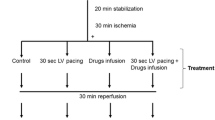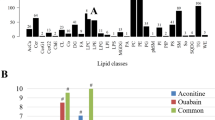Abstract
Myocardial cell vulnerability to phospholipase C (PC-PLC) attack was investigated in three different preparations of rat myocardial cells: triacylglycerol (TG)-loaded, hypothermic/rewarmed and energy depleted myocytes. The attack by PC-PLC was evaluated as PC-PLC induced glycerol output due to the combined action of phospholipase C and intracellular lipases. PC-PLC induced glycerol output was significantly higher (p < 0.05) in all three myocyte preparations, compared to their respective controls. Cell morphology (% rod shaped myocytes) of TG-loaded or hypothermic/rewarmed myocytes was not different from their controls, whereas energy depleted myocytes almost exclusively were rounded up, due to hypercontraction of the myofilaments. Hypothermic/rewarmed and energy depleted myocytes showed a significantly higher release of lactate dehydrogenase (LDH), compared to their controls although the difference was much more pronounced in the latter. Finally, the cellular contents of ATP were maintained both in TG-loaded and hypothermic rewarmed myocytes, while energy depleted myocytes contained only about 25% of the normal ATP level. These results demonstrate that attack from exogenously added phospholipases can occur, not only in seriously damaged cardiac myocytes, but in myocytes with a more subtle damage as well. (Mol Cell Biochem 116: 47–52, 1992)
Similar content being viewed by others
References
Van der Vusse GJ, van Bilsen M, Reneman RS: Is phospholipid degradation a critical event in ischemia- and reperfusion-induced damage? News in Physiological Sciences 4: 49–53, 1989
Stenbergen C, Jennings RB: Relationship between lysophospholipid accumulation and plasma membrane injury during total in vitro ischemia in dog heart. J Mol Cell Cardiol 16: 605–621, 1984
Van der Vusse GJ, Roemen THM, Prinzen FW, Coumans WA, Reneman RS: Uptake and tissue content of fatty acids in dog myocardium under normoxic and ischemic conditions. Circ Res 50: 538–546, 1982
Myrmel T, Larsen T, Forsdahl K, Skulberg A, Little C: Phospholipase C-evoked glycerol release in energy depleted rat myocardial cells. Mol Cell Biochem 88: 139–144, 1989
Katz AM, Messineo FC: Lipid-membrane interactions and the pathogenesis of ischemic damage in the myocardium. Ore Res 48: 1–16, 1981
Gordon LM, Sauerheber RD, Esgate JA: Spin label studies on rat liver and heart plasma membranes: Effects of temperature, calcium, and lanthanum on membrane fluidity. J Supramol Struct 9: 283–310, 1978
Verkleij AJ, Post JA: Physico-chemical properties and organization of lipids in membranes: their possible role in myocardial injury. In: H Stam, GJ van der Vusse, (eds.) 1987, pp 85–91 Lipid metabolism in the normoxic and ischemic heart
Larsen TG, Myrmel T, Skulberg A, Severson DL, Mjøs OD: Effects of hypoxia on lipolysis in isolated rat myocardial cells. Mol Cell Biochem 88: 139–144, 1989
Chernick SS: Determination of glycerol in acyl glycerols. Methods in enzymology 14: 627–630, 1969
Moss D W: The measurements of enzymes. In: DJ Hearse and de Leiris (eds.), 1979, Enzymes in cardiology, John Wiley and Sons, pp 154–198,1979
Sellevold OFM, Jynge P, Aarstad K: High performance liquid chromatography: a rapid isocratic method for determination of creatine compounds and adenine nucleotides in myocardial tissue. J Mol Cell Cardiol 18: 517–527, 1986
Myrnes BJ, Little C: A simple purification scheme yielding crystalline phospholipase C from Bacillus cereus. Acta Chem Scand B 34: 375–377, 1980
Little C: Phospholipase C from Bacillus cercus. Methods Enzymol 71: 725–730, 1981
Rottem S, Hasin M, Razin S: Differences in susceptibility to phospholipase C of free and membrane-bound phospholipids of Mycoplasma hominis. Biochim Biophys Acta 323: 520–531, 1973
Roelofsen B: Phospholipases as tools to study the localization of phospholipids in biological membranes. A critical review. J Toxicol Toxin Reviews 1: 87–197, 1982
Op den Kamp JAF, de Gier J, van Deenen LLM: Hydrolysis of phosphatidylcholine liposomes by pancreatic phospholipase Az at the transition temperature. Biochim Biophys Acta 345: 253–256, 1974
Kenno KA, Severson DL: Lipolysis in isolated myocardial cells from diabetic rat hearts. Am J Physiol 249: H1024-H1030, 1985
Larsen TS, Severson DL: Influence of exogenous fatty acids and ketone bodies on rates of lipolysis in isolated ventricular myocytes from normal and diabetic rats. Can J Physiol Pharmacol 68: 177–182, 1990
Corr PB, Gross RW, Sobel BE: Amphiphatic metabolites and membranes dysfunction in ischemic myocardium. Circ Res 55: 135–154, 1984
Author information
Authors and Affiliations
Rights and permissions
About this article
Cite this article
Steigen, T.K., Myrmel, T., Forsdahl, K. et al. Myocardial cell vulnerability to exogenous phospholipase attack. Mol Cell Biochem 116, 47–52 (1992). https://doi.org/10.1007/BF01270568
Issue Date:
DOI: https://doi.org/10.1007/BF01270568




